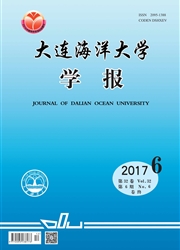

 中文摘要:
中文摘要:
为研究岩扇贝Crassadoma gigante的代谢生理状况,为其人工育苗和规模化养殖提供依据,采用不同生态条件对岩扇贝幼贝耗氧率和排氨率进行了相关研究。结果表明:温度、盐度、p H和体质量对岩扇贝幼贝耗氧率、排氨率均有极显著影响(P〈0.01);在试验温度为6~22℃时,岩扇贝幼贝单位体质量的耗氧率、排氨率随温度的升高而增大;经回归分析,体质量(X)与耗氧率或排氨率(Y)均呈负相关幂指数关系,岩扇贝幼贝单位体质量的耗氧率、排氨率随体质量的增大而降低;岩扇贝幼贝的耗氧率与排氨率先随盐度(24~30)的升高而增大,在盐度为30时达到最大值,而后随盐度(30~36)的升高而降低;岩扇贝幼贝的耗氧率与排氨率先随p H(7.0~8.0)的升高而增大,在盐度为8.0时达到最大值,而后随p H(8.0~9.0)的升高而降低;岩扇贝幼贝一昼夜的耗氧率及排氨率最高峰均在13:00,耗氧率和排氨率最低峰均在1:00。本研究结果可为岩扇贝的生理生态学研究提供理论依据。
 英文摘要:
英文摘要:
In this study,the effects of temperature, salinity, pH,and body weight on oxygen consumption rate and ammonia excretion rate were studied in rock scallop Crassadoma gigantea introduced in 2013 to provide the basis for study of the physiological ecology of the scallop and the guidance to production practice. The results showed that oxygen consumption rate and ammonia excretion rate in juvenile rock scallop were significantly affected by tempera-ture , salinity, pH,and body weight( P〈0. 01 ) , increased with the rise of temperature within 6-22 ℃. The regres-sion analysis revealed that relationship between body weight (X ) and oxygen consumption rate or ammonia excretion rate (Y) was expressed as negative exponential relationship. The oxygen consumption rate and ammonia excretion rate per unit body weight were decreased with the increase in body weight,and increased with the increase in salin-ity from 24 to 30,the maximum at salinity of 3 0,and then decreased with the increase in salinity from 30 to 36; in-creased with the increase in pH from 7.0 to 8. 0 ,the maximum at salinity of 8.0,and then decreased with the in-crease in salinity from 8.0 to 9. 0. The peak of oxygen consumption rate and ammonia excretion rate were observed at 13:00,the minimal oxygen consumption rate at 21:00 and the minimal ammonia excretion rate at 1:00. The findings provide reference with physiological and ecological research in rock scallop.
 同期刊论文项目
同期刊论文项目
 同项目期刊论文
同项目期刊论文
 期刊信息
期刊信息
